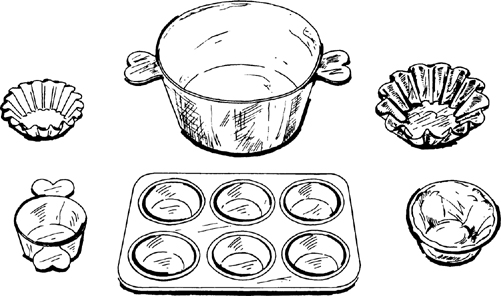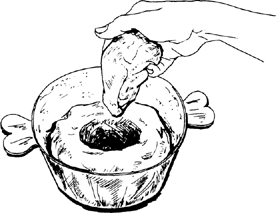Mastering the Art of French Cooking, Volume 2 (41 page)
Read Mastering the Art of French Cooking, Volume 2 Online
Authors: Julia Child

With the help of a scraper or spatula, flip the right side of the dough over toward the center, then flip the left side over to cover it, as though folding a business letter
. Pat the dough out again into a rectangle, fold again in three, and replace the dough in the bowl. Cover again with plastic and a towel.
(*) If you want to freeze
brioche
dough, this is the best time to do so, but see
notes on freezing
.
7)
Second rising—pointage deuxième temps—2 to 6 hours or more, depending on temperature
Brioche
dough is usually chilled before it is formed so that it can be shaped easily; chilling may be done either during or after the second rise, whichever works out best for your cooking schedule.
room temperature method:
Let dough rise to 2 times its original volume, or to about 5½ cups, at a temperature of around 70 degrees. This should take 1½ to 2 hours. Then dislodge from bowl with a rubber spatula or the slightly cupped fingers of one hand, and refrigerate on a large plate or platter covered with waxed paper, another plate, and a weight. Dough should be ready to form in 30 to 40 minutes.
refrigerator method:
Let dough start to rise at around 70 degrees for an hour, then refrigerate. Dough will continue to rise for an hour or more until the butter congeals. If you wish to leave it overnight, cover with a plate and a weight when you refrigerate it.
Forming and baking brioches
Brioches are usually baked in fluted molds with slightly outward-slanting sides. However, you can use anything you have available, from a baking dish or ovenproof bowl for large brioches to pyrex cups or muffin tins for small ones
.
Notes on final rise
The final rise before baking is to almost double in volume, until the dough feels light and softly springy when touched. The ideal rising temperature is around 75 degrees, and you have to watch the dough carefully on a hot day because higher temperatures melt the butter so that it oozes out of the dough. If this starts to happen, refrigerate the dough from time to time. It is difficult to predict how long the final rise will take; if the dough was thoroughly chilled before forming, it will take longer to rise. You must usually count on at least an hour, and it must really rise and soften or it will bake into a rather firm and dense
brioche
. Following are directions for forming and baking large, small, and ring
brioches
.

GROSSE BRIOCHE À TÊTE
[Large
Brioche
with Ball-shaped Head]
1)
Forming the brioche
1 tsp soft butter
A 6-cup circular fluted mold or a cylindrical baking dish
The preceding
brioche
dough, chilled
Butter the interior of the mold or dish. With lightly floured hands on a lightly floured board, form ¾ of the dough into a smooth ball by kneading it lightly and rolling it between the palms of your hands. Place the ball in the bottom of the mold.
| Make a funnel-shaped hole in the center of the dough 2½ inches wide at the top diameter and about 2 inches deep, using your first 3 fingers. Roll the remaining dough between the lightly floured palms of your hands to make a ball, then a tear-drop shape. |
2)
Final rising—1 to 2 hours at 75 degrees
Set uncovered and free from drafts at a temperature of around 75 degrees until dough has almost doubled in volume, and feels light and softly springy when touched. Be sure your oven has been preheated to 475 degrees by the time the
brioche
is ready to bake.
(*)
DELAYED ACTION
: You can set mold in refrigerator, covering it with a bowl to prevent dough from crusting; you can cover the formed dough airtight and freeze, but see
notes
.




